Critical Evaluation of 'Bottom of Pyramid' Concept and Its Potential to Alleviate Poverty
VerifiedAdded on 2023/01/11
|6
|1333
|79
AI Summary
This report critically evaluates the concept of 'Bottom of Pyramid' and its potential to alleviate poverty. It discusses the market-based model of economic development, strategies for tapping into BOP markets, and the role of governments and MNCs in reducing poverty.
Contribute Materials
Your contribution can guide someone’s learning journey. Share your
documents today.
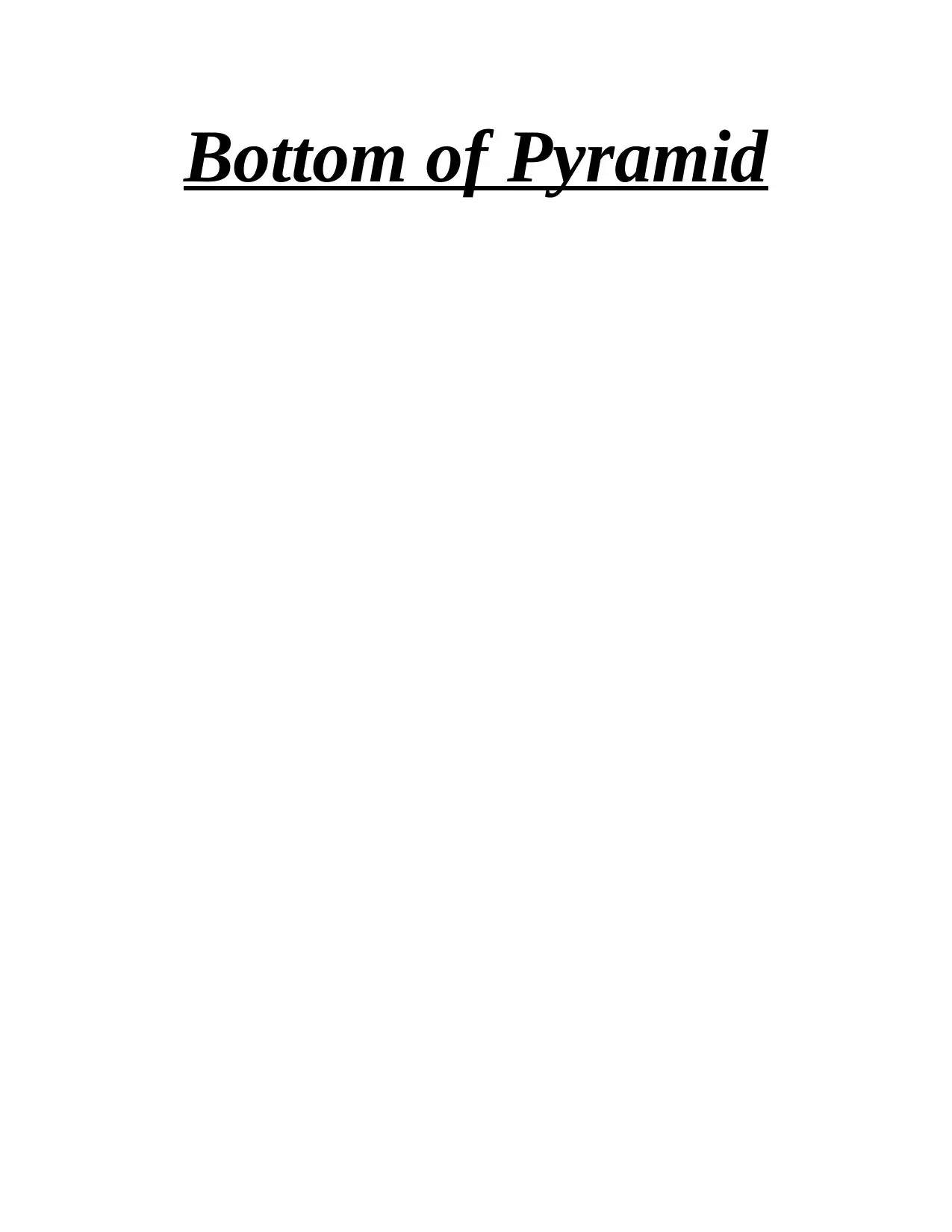
Bottom of Pyramid
Secure Best Marks with AI Grader
Need help grading? Try our AI Grader for instant feedback on your assignments.
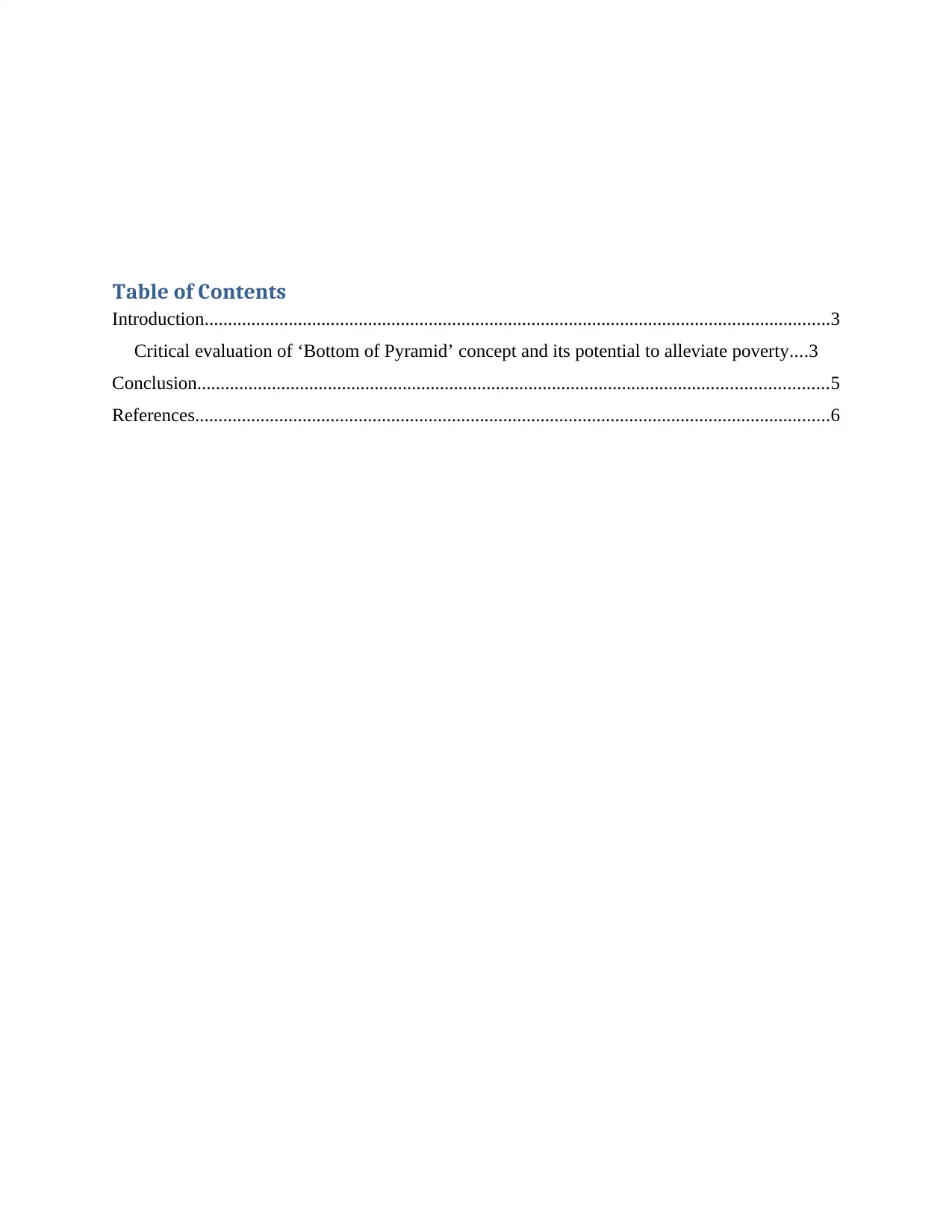
Table of Contents
Introduction......................................................................................................................................3
Critical evaluation of ‘Bottom of Pyramid’ concept and its potential to alleviate poverty....3
Conclusion.......................................................................................................................................5
References........................................................................................................................................6
Introduction......................................................................................................................................3
Critical evaluation of ‘Bottom of Pyramid’ concept and its potential to alleviate poverty....3
Conclusion.......................................................................................................................................5
References........................................................................................................................................6
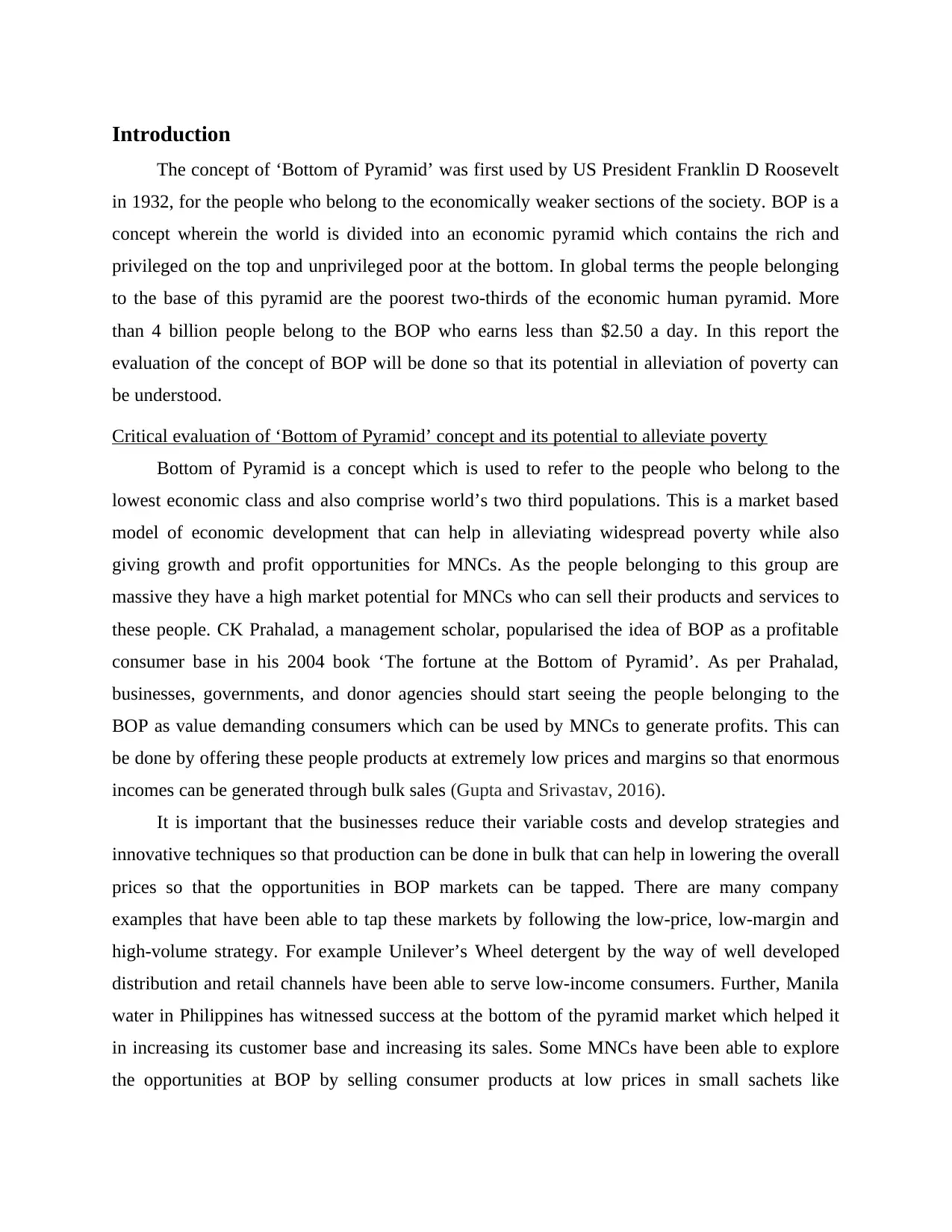
Introduction
The concept of ‘Bottom of Pyramid’ was first used by US President Franklin D Roosevelt
in 1932, for the people who belong to the economically weaker sections of the society. BOP is a
concept wherein the world is divided into an economic pyramid which contains the rich and
privileged on the top and unprivileged poor at the bottom. In global terms the people belonging
to the base of this pyramid are the poorest two-thirds of the economic human pyramid. More
than 4 billion people belong to the BOP who earns less than $2.50 a day. In this report the
evaluation of the concept of BOP will be done so that its potential in alleviation of poverty can
be understood.
Critical evaluation of ‘Bottom of Pyramid’ concept and its potential to alleviate poverty
Bottom of Pyramid is a concept which is used to refer to the people who belong to the
lowest economic class and also comprise world’s two third populations. This is a market based
model of economic development that can help in alleviating widespread poverty while also
giving growth and profit opportunities for MNCs. As the people belonging to this group are
massive they have a high market potential for MNCs who can sell their products and services to
these people. CK Prahalad, a management scholar, popularised the idea of BOP as a profitable
consumer base in his 2004 book ‘The fortune at the Bottom of Pyramid’. As per Prahalad,
businesses, governments, and donor agencies should start seeing the people belonging to the
BOP as value demanding consumers which can be used by MNCs to generate profits. This can
be done by offering these people products at extremely low prices and margins so that enormous
incomes can be generated through bulk sales (Gupta and Srivastav, 2016).
It is important that the businesses reduce their variable costs and develop strategies and
innovative techniques so that production can be done in bulk that can help in lowering the overall
prices so that the opportunities in BOP markets can be tapped. There are many company
examples that have been able to tap these markets by following the low-price, low-margin and
high-volume strategy. For example Unilever’s Wheel detergent by the way of well developed
distribution and retail channels have been able to serve low-income consumers. Further, Manila
water in Philippines has witnessed success at the bottom of the pyramid market which helped it
in increasing its customer base and increasing its sales. Some MNCs have been able to explore
the opportunities at BOP by selling consumer products at low prices in small sachets like
The concept of ‘Bottom of Pyramid’ was first used by US President Franklin D Roosevelt
in 1932, for the people who belong to the economically weaker sections of the society. BOP is a
concept wherein the world is divided into an economic pyramid which contains the rich and
privileged on the top and unprivileged poor at the bottom. In global terms the people belonging
to the base of this pyramid are the poorest two-thirds of the economic human pyramid. More
than 4 billion people belong to the BOP who earns less than $2.50 a day. In this report the
evaluation of the concept of BOP will be done so that its potential in alleviation of poverty can
be understood.
Critical evaluation of ‘Bottom of Pyramid’ concept and its potential to alleviate poverty
Bottom of Pyramid is a concept which is used to refer to the people who belong to the
lowest economic class and also comprise world’s two third populations. This is a market based
model of economic development that can help in alleviating widespread poverty while also
giving growth and profit opportunities for MNCs. As the people belonging to this group are
massive they have a high market potential for MNCs who can sell their products and services to
these people. CK Prahalad, a management scholar, popularised the idea of BOP as a profitable
consumer base in his 2004 book ‘The fortune at the Bottom of Pyramid’. As per Prahalad,
businesses, governments, and donor agencies should start seeing the people belonging to the
BOP as value demanding consumers which can be used by MNCs to generate profits. This can
be done by offering these people products at extremely low prices and margins so that enormous
incomes can be generated through bulk sales (Gupta and Srivastav, 2016).
It is important that the businesses reduce their variable costs and develop strategies and
innovative techniques so that production can be done in bulk that can help in lowering the overall
prices so that the opportunities in BOP markets can be tapped. There are many company
examples that have been able to tap these markets by following the low-price, low-margin and
high-volume strategy. For example Unilever’s Wheel detergent by the way of well developed
distribution and retail channels have been able to serve low-income consumers. Further, Manila
water in Philippines has witnessed success at the bottom of the pyramid market which helped it
in increasing its customer base and increasing its sales. Some MNCs have been able to explore
the opportunities at BOP by selling consumer products at low prices in small sachets like

shampoos, toothpastes, hair oils etc. This has helped the companies in reaching to these
customers effectively and serves a large market of the people belonging to BOP.
It is also important that the government of the countries having a large number of people in
the category of BOP help in improving the purchasing power of these people by providing them
with minimum wages and providing them with other consumer products at subsidised rates. This
can help in increasing their savings so that their purchasing power can increase like done by the
Chinese and Indian governments. Better social welfare systems, subsidized housing, medical
insurance etc. are helpful in reducing their financial burden so that they can afford a better life
and also it can help the MNCs in capturing the potential markets of the low-income groups. The
people belonging to this group in China are employed in production industries so that they can
earn a basic living and minimum wages can be given to them that can help in alleviating poverty.
In India under the MG-NAREGA scheme poor people are given a basic minimum wage which
help in improving their living standard and increase their purchasing potential (Chatterjee, Gupta
and Upadhyay, 2018). Also the governments can provide these people consumer goods at
subsidized rates so that poverty can be alleviated and they can start falling in the middle class
section of the economic pyramid.
MNCs can also use the potential of these markets through increasing innovation so that the
products and services can be offered at low prices for example MODEM, a Microfinance
organisation in South America developed a credit card system where different users can share a
single card having their personal code of transactions. This helped in reducing the cost of service
and helped in enlarging the customer base so that low income group people can make use of this
system (Berger, 2016). Thus it is important that the companies come up with innovative ideas so
that they can reach to the large base of customers belonging to BOP which can help in increasing
their customer base and also in contributing to their profits. Parle, PepsiCo and Dabur have thus
come up with idea of selling their goods in small sachet which are low priced so that they can
reach to this customer based through frugal innovation.
Bundled services can also be given to customers that can help in reducing the time and
money spent by them in gaining the needed products so that the value of customers can also be
increased. For examples, D.Light and Duron provide both light and capacity for recharging cell
phones so that bundle of servicers can be given (Yurdakul, Atik and Dholakia, 2017). MNCs can
also give services to customers that can engage them and give them high satisfaction for example
customers effectively and serves a large market of the people belonging to BOP.
It is also important that the government of the countries having a large number of people in
the category of BOP help in improving the purchasing power of these people by providing them
with minimum wages and providing them with other consumer products at subsidised rates. This
can help in increasing their savings so that their purchasing power can increase like done by the
Chinese and Indian governments. Better social welfare systems, subsidized housing, medical
insurance etc. are helpful in reducing their financial burden so that they can afford a better life
and also it can help the MNCs in capturing the potential markets of the low-income groups. The
people belonging to this group in China are employed in production industries so that they can
earn a basic living and minimum wages can be given to them that can help in alleviating poverty.
In India under the MG-NAREGA scheme poor people are given a basic minimum wage which
help in improving their living standard and increase their purchasing potential (Chatterjee, Gupta
and Upadhyay, 2018). Also the governments can provide these people consumer goods at
subsidized rates so that poverty can be alleviated and they can start falling in the middle class
section of the economic pyramid.
MNCs can also use the potential of these markets through increasing innovation so that the
products and services can be offered at low prices for example MODEM, a Microfinance
organisation in South America developed a credit card system where different users can share a
single card having their personal code of transactions. This helped in reducing the cost of service
and helped in enlarging the customer base so that low income group people can make use of this
system (Berger, 2016). Thus it is important that the companies come up with innovative ideas so
that they can reach to the large base of customers belonging to BOP which can help in increasing
their customer base and also in contributing to their profits. Parle, PepsiCo and Dabur have thus
come up with idea of selling their goods in small sachet which are low priced so that they can
reach to this customer based through frugal innovation.
Bundled services can also be given to customers that can help in reducing the time and
money spent by them in gaining the needed products so that the value of customers can also be
increased. For examples, D.Light and Duron provide both light and capacity for recharging cell
phones so that bundle of servicers can be given (Yurdakul, Atik and Dholakia, 2017). MNCs can
also give services to customers that can engage them and give them high satisfaction for example
Paraphrase This Document
Need a fresh take? Get an instant paraphrase of this document with our AI Paraphraser
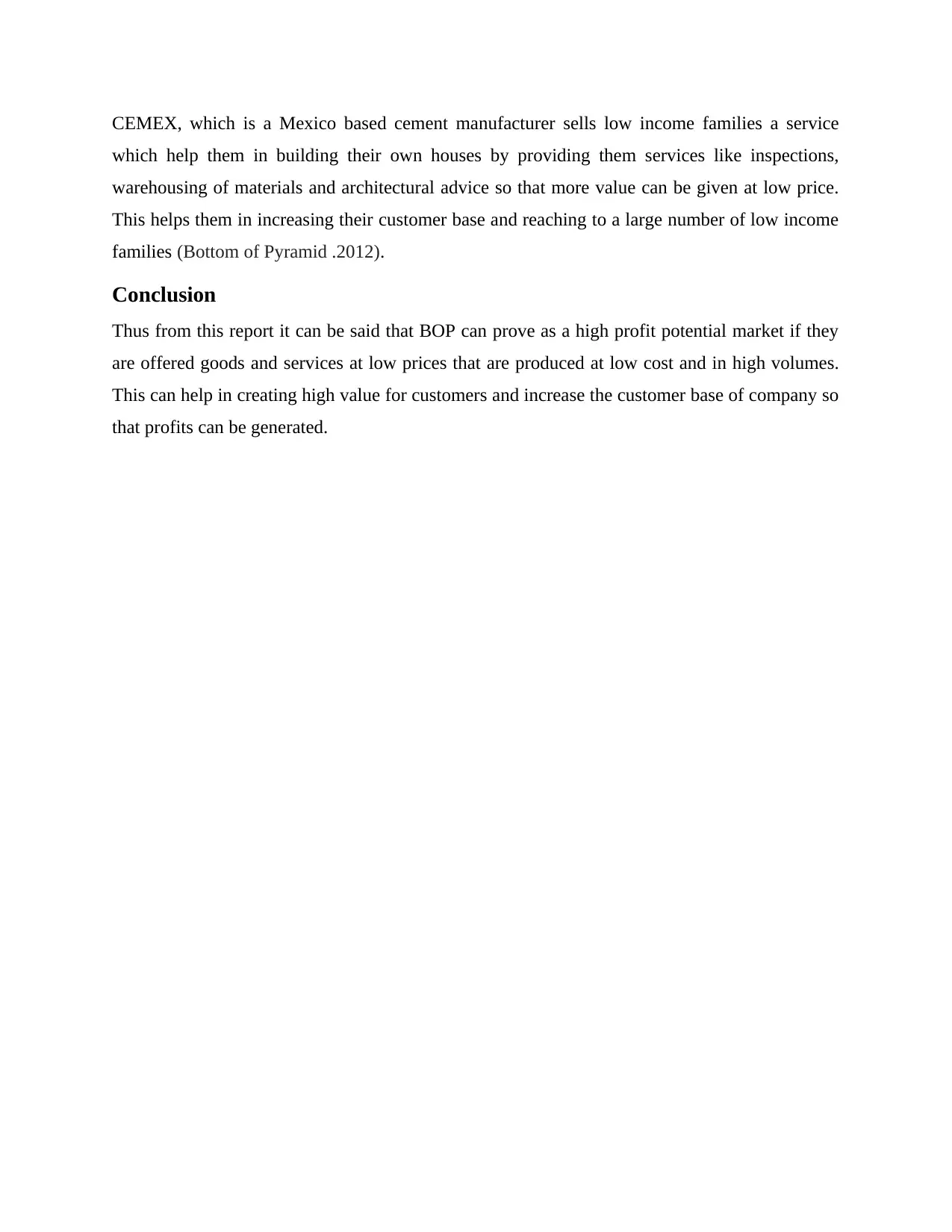
CEMEX, which is a Mexico based cement manufacturer sells low income families a service
which help them in building their own houses by providing them services like inspections,
warehousing of materials and architectural advice so that more value can be given at low price.
This helps them in increasing their customer base and reaching to a large number of low income
families (Bottom of Pyramid .2012).
Conclusion
Thus from this report it can be said that BOP can prove as a high profit potential market if they
are offered goods and services at low prices that are produced at low cost and in high volumes.
This can help in creating high value for customers and increase the customer base of company so
that profits can be generated.
which help them in building their own houses by providing them services like inspections,
warehousing of materials and architectural advice so that more value can be given at low price.
This helps them in increasing their customer base and reaching to a large number of low income
families (Bottom of Pyramid .2012).
Conclusion
Thus from this report it can be said that BOP can prove as a high profit potential market if they
are offered goods and services at low prices that are produced at low cost and in high volumes.
This can help in creating high value for customers and increase the customer base of company so
that profits can be generated.
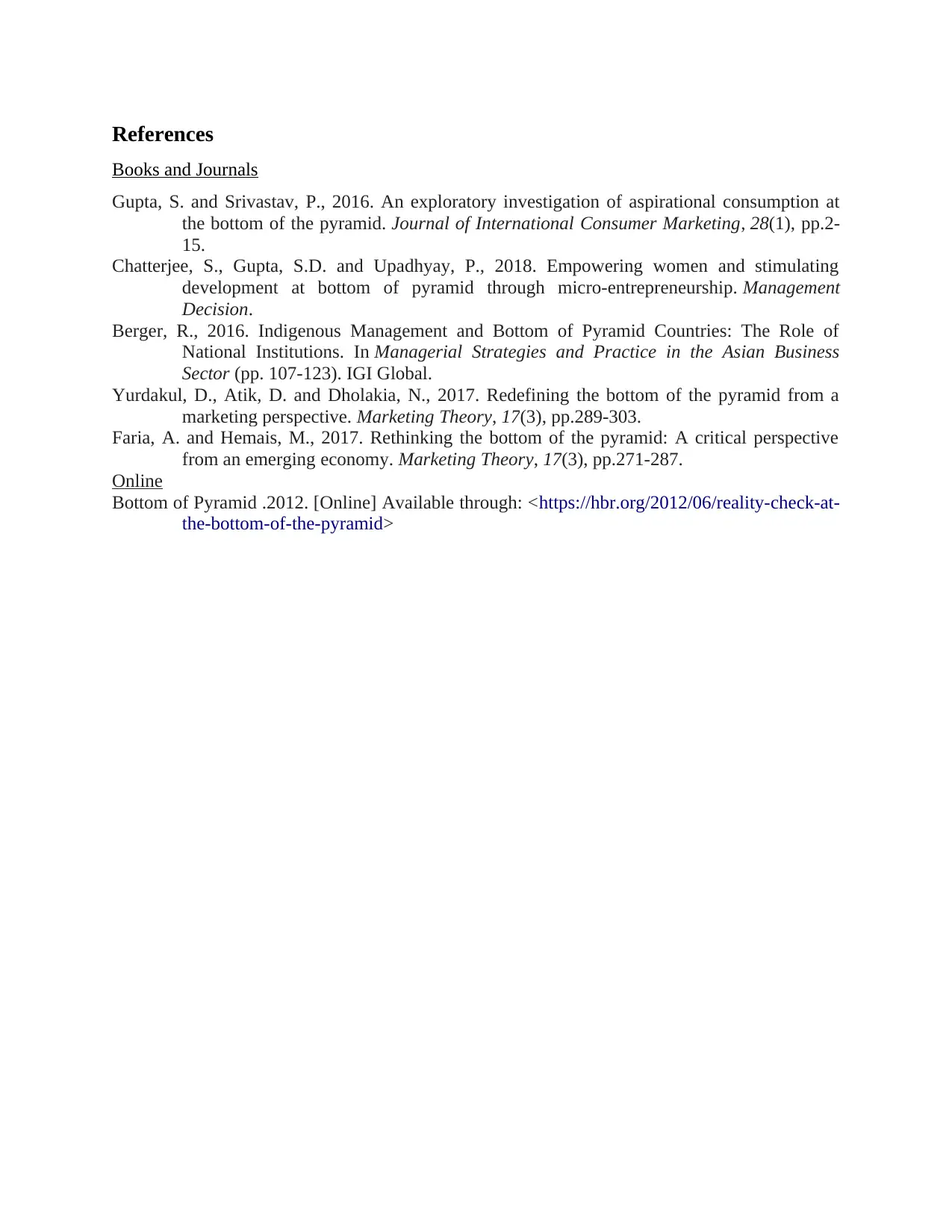
References
Books and Journals
Gupta, S. and Srivastav, P., 2016. An exploratory investigation of aspirational consumption at
the bottom of the pyramid. Journal of International Consumer Marketing, 28(1), pp.2-
15.
Chatterjee, S., Gupta, S.D. and Upadhyay, P., 2018. Empowering women and stimulating
development at bottom of pyramid through micro-entrepreneurship. Management
Decision.
Berger, R., 2016. Indigenous Management and Bottom of Pyramid Countries: The Role of
National Institutions. In Managerial Strategies and Practice in the Asian Business
Sector (pp. 107-123). IGI Global.
Yurdakul, D., Atik, D. and Dholakia, N., 2017. Redefining the bottom of the pyramid from a
marketing perspective. Marketing Theory, 17(3), pp.289-303.
Faria, A. and Hemais, M., 2017. Rethinking the bottom of the pyramid: A critical perspective
from an emerging economy. Marketing Theory, 17(3), pp.271-287.
Online
Bottom of Pyramid .2012. [Online] Available through: <https://hbr.org/2012/06/reality-check-at-
the-bottom-of-the-pyramid>
Books and Journals
Gupta, S. and Srivastav, P., 2016. An exploratory investigation of aspirational consumption at
the bottom of the pyramid. Journal of International Consumer Marketing, 28(1), pp.2-
15.
Chatterjee, S., Gupta, S.D. and Upadhyay, P., 2018. Empowering women and stimulating
development at bottom of pyramid through micro-entrepreneurship. Management
Decision.
Berger, R., 2016. Indigenous Management and Bottom of Pyramid Countries: The Role of
National Institutions. In Managerial Strategies and Practice in the Asian Business
Sector (pp. 107-123). IGI Global.
Yurdakul, D., Atik, D. and Dholakia, N., 2017. Redefining the bottom of the pyramid from a
marketing perspective. Marketing Theory, 17(3), pp.289-303.
Faria, A. and Hemais, M., 2017. Rethinking the bottom of the pyramid: A critical perspective
from an emerging economy. Marketing Theory, 17(3), pp.271-287.
Online
Bottom of Pyramid .2012. [Online] Available through: <https://hbr.org/2012/06/reality-check-at-
the-bottom-of-the-pyramid>
1 out of 6
![[object Object]](/_next/static/media/star-bottom.7253800d.svg)





